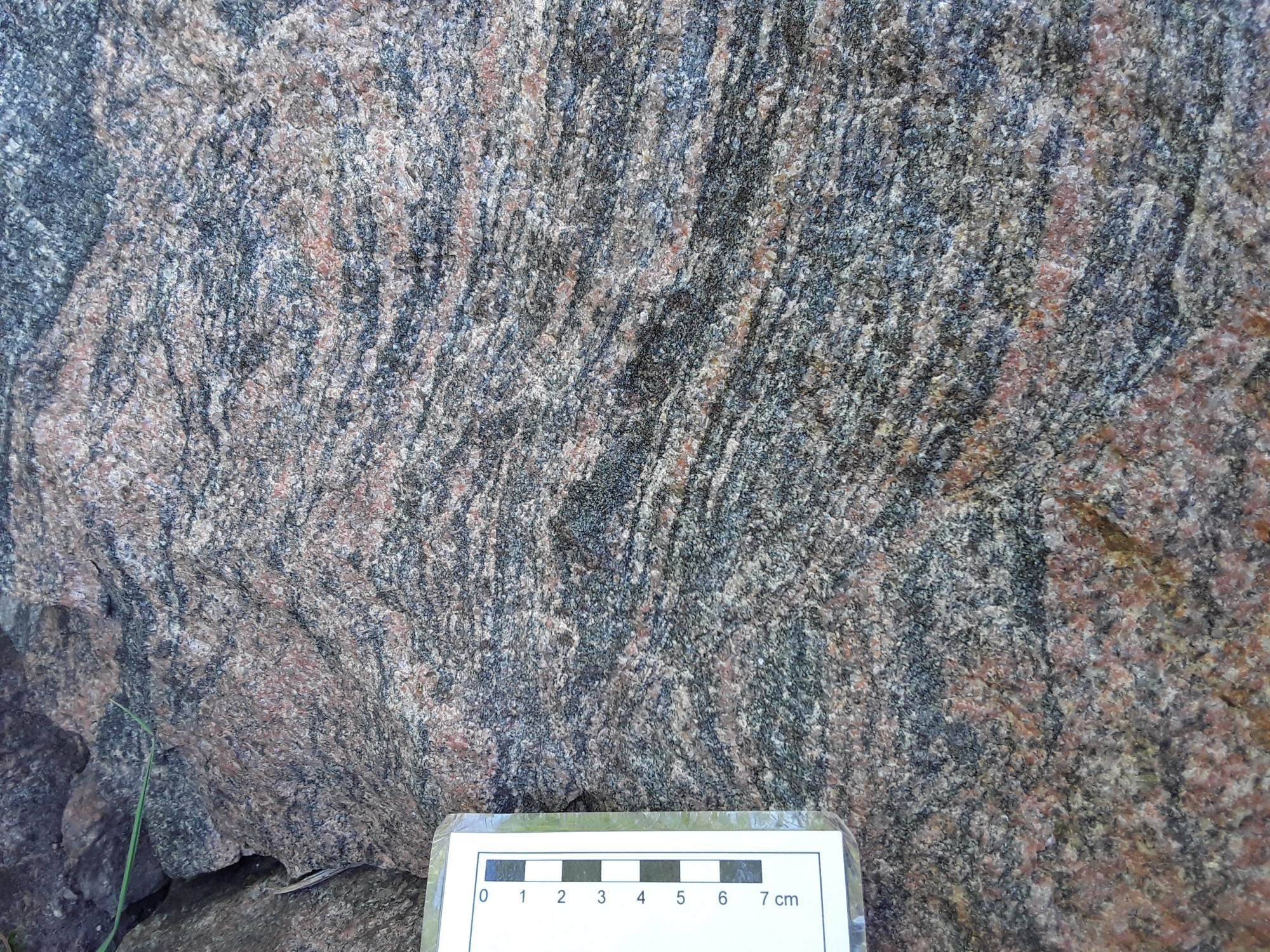
DISCLAIMER: This English version is translated from the original French. In case of any discrepancy, the French version shall prevail.
| Author(s): | Bilodeau, 2022 |
| Age: | Mesoproterozoic |
| Stratotype: | Reference outcrops 2021-CB-1057 and 2021-CB-1063 |
| Type area: | Île-du-Grand-Calumet area (NTS sheet 31F10) |
| Geological province: | Grenville Province |
| Geological subdivision: | Allochton |
| Lithology: | Intermediate to felsic intrusive rocks |
| Category: | Lithodemic |
| Rank: | Suite |
| Status: | Formal |
| Use: | Active |
None
Background
The Tancredia Intrusive Suite was introduced by Bilodeau (2022) during geological mapping of the Île-du-Grand-Calumet area in 2021. The rocks in this unit were first described by Osborne (1944) as dykes and sills of fine-grained pink granite. The term « pink granite » was dropped in subsequent reports. Madore et al. (1994) then grouped these rocks together in a lithological unit of charnockitic gneiss. Finally, the individualization of the « Tancredia intrusion » associated with the « Obwondiag Complex » (now the Grand-Calumet Complex, mPgrc2) is mentioned in Adair’s (2018) prospecting report.
Description
The Tancredia Intrusive Suite is subdivided into two informal units on the basis of their differences in composition, texture and geochemical affinity. Unit mPtcd1 corresponds to an intrusion of transitional to tholeiitic geochemical affinity whose composition varies from a quartz syenite to an alkali to monzonitic feldspar granite. The other intrusions are grouped in a granite and granodiorite unit of calc-alkaline affinity (mPtcd2).
Tancredia Intrusive Suite 1 (mPtcd1): Quartz syenite to alkali feldspar granite, monzonite
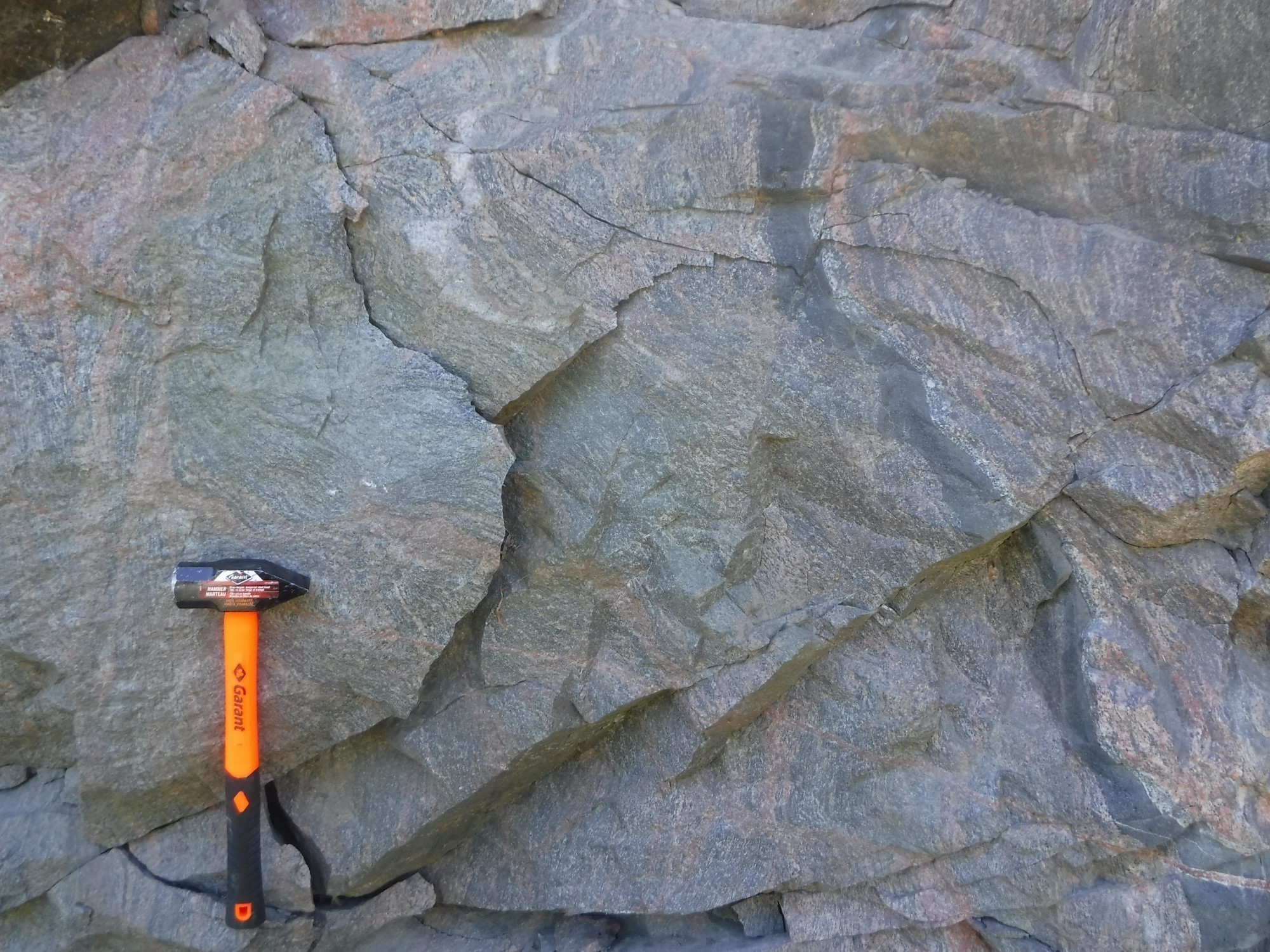
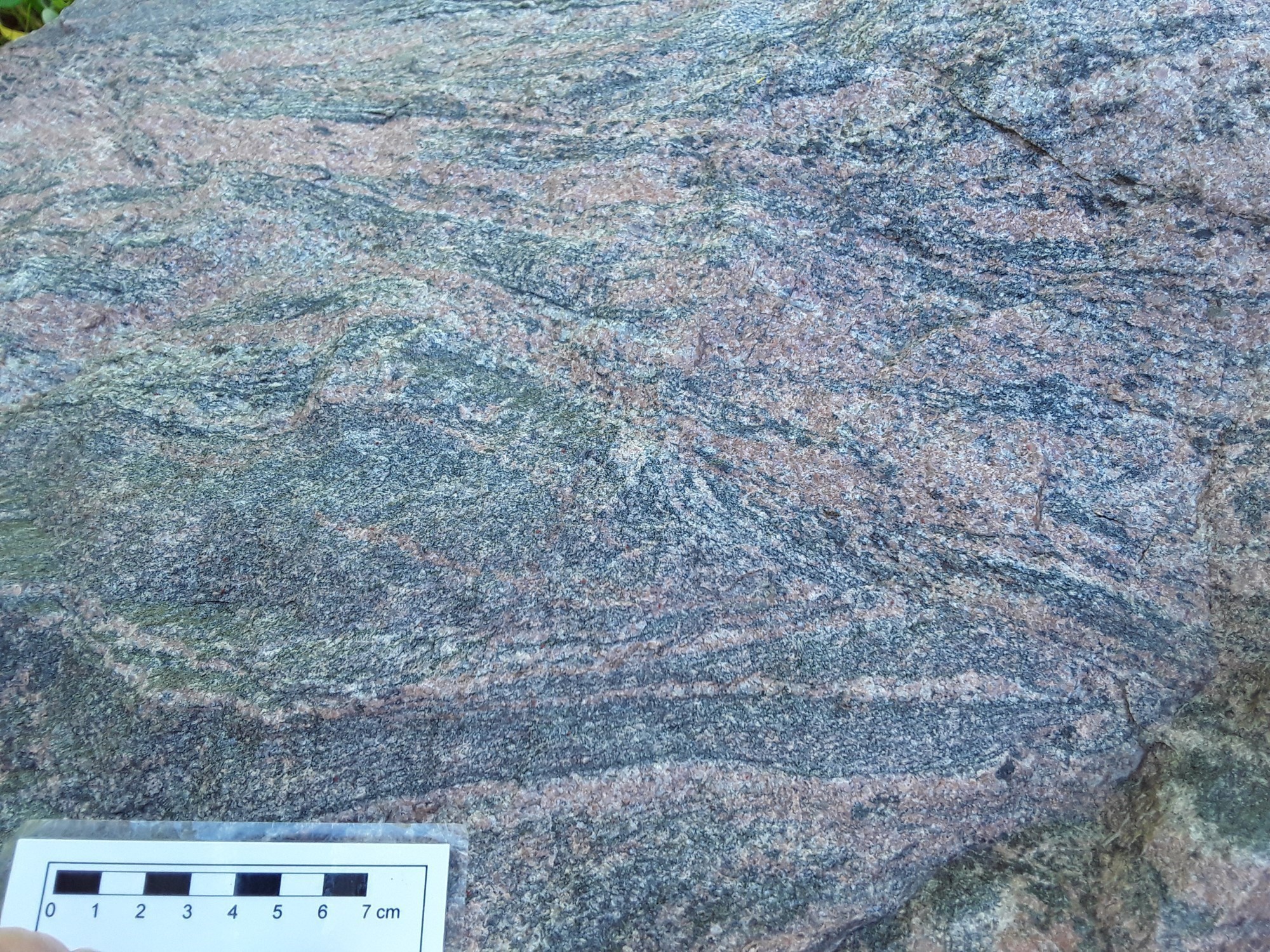
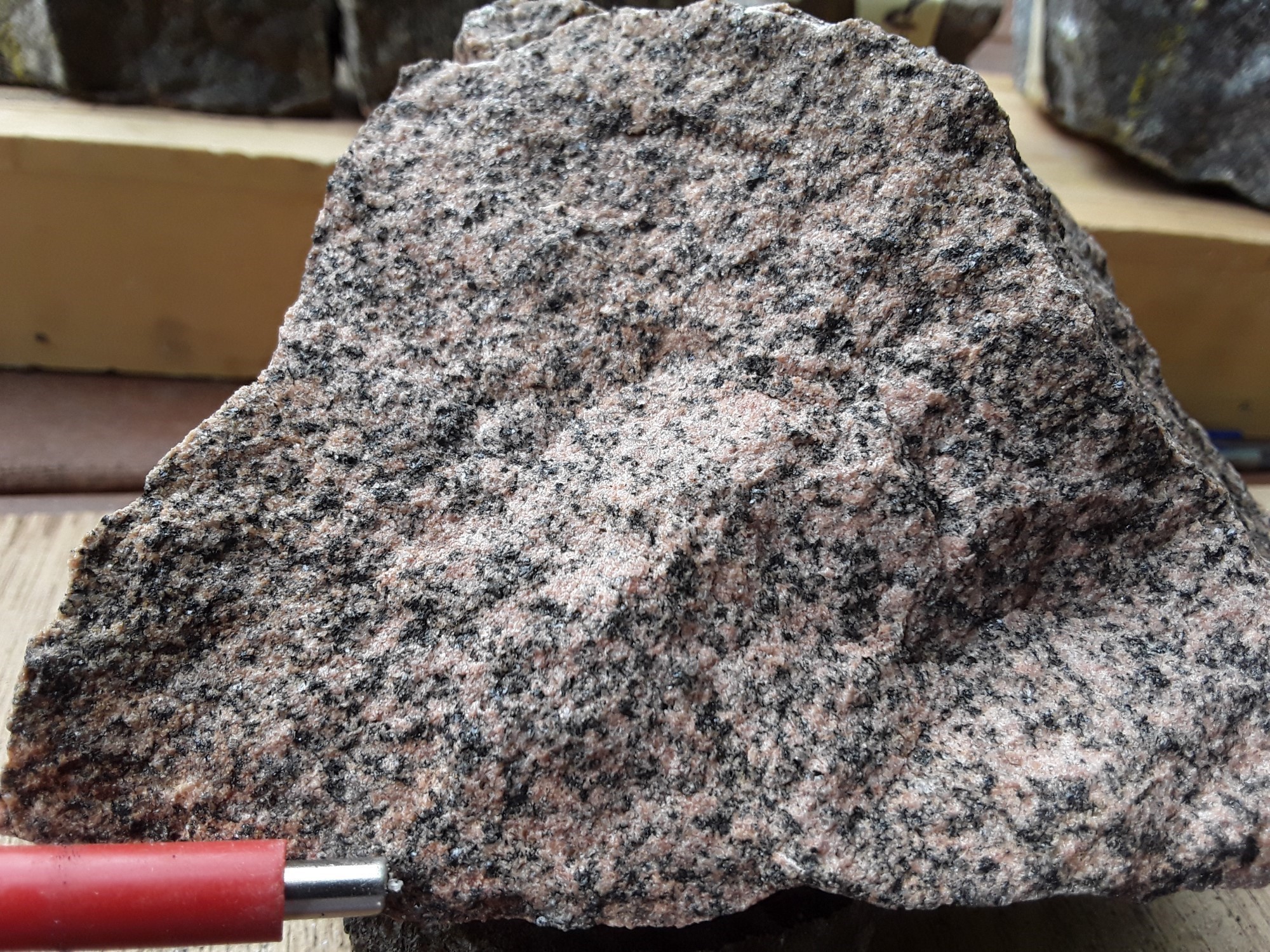 Depending on the composition observed, the rocks in this unit varies in colour from pinkish-grey to greenish-grey in fresh surface and from pinkish-grey to brownish in altered patina. They are composed of 10% to 30% quartz, a variable amount of plagioclase and up to 55% K-feldspar. Secondary minerals include 2% to 10% biotite, 1% to 5% hornblende, 5% to 7% opaque minerals dominated by magnetite, 1% to 2% clinopyroxene in some samples and possibly a few orthopyroxene crystals replaced by hornblende and biotite. Accessory minerals include apatite, titanite, garnet and muscovite. The rock is characterized by a heterogeneous distribution of ferromagnesian minerals. Overall, the unit has a very strong magnetic susceptibility.
Depending on the composition observed, the rocks in this unit varies in colour from pinkish-grey to greenish-grey in fresh surface and from pinkish-grey to brownish in altered patina. They are composed of 10% to 30% quartz, a variable amount of plagioclase and up to 55% K-feldspar. Secondary minerals include 2% to 10% biotite, 1% to 5% hornblende, 5% to 7% opaque minerals dominated by magnetite, 1% to 2% clinopyroxene in some samples and possibly a few orthopyroxene crystals replaced by hornblende and biotite. Accessory minerals include apatite, titanite, garnet and muscovite. The rock is characterized by a heterogeneous distribution of ferromagnesian minerals. Overall, the unit has a very strong magnetic susceptibility.
The rocks are generally highly foliated, to the extent that some outcrops display a well-developed gneissosity. Foliation is determined by the alignment of fine biotite crystals, giving the rock a granolepidoblastic texture (Madore et al., 1994). Numerous granite injections concordant with foliation are present. Madore et al. (1994) hypothesized that the injections represent mobilisates that have acquired an orientation parallel to the foliation.
Tancredia Intrusive Suite 2 (mPtcd2): Granite, granodiorite
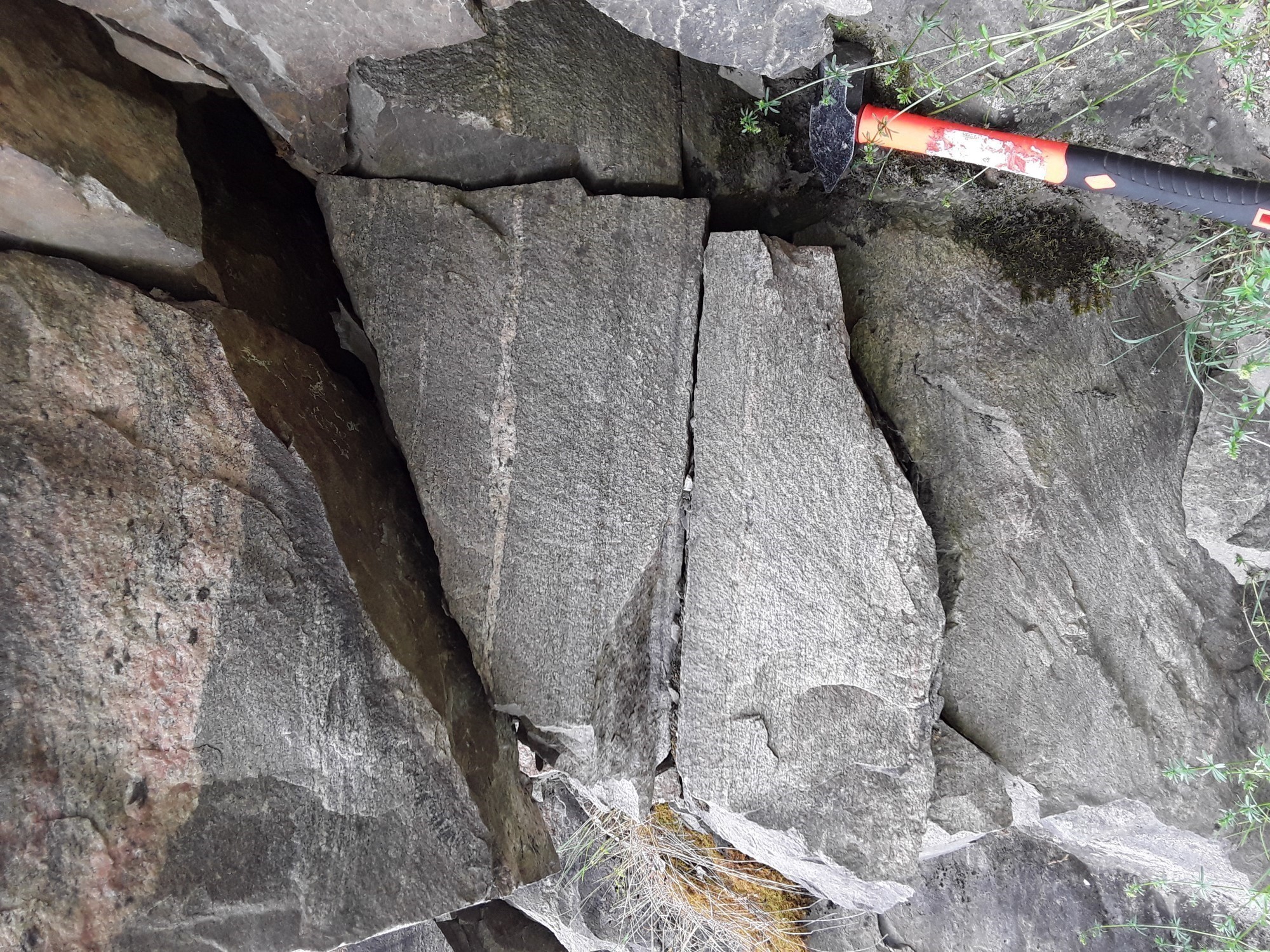 The mPtcd2 unit is composed of granitic to granodioritic rocks, with a light to dark grey fresh surface and a light greyish-beige alteration patina. The minerals are generally fine grained, with the exception of quartz which is also present in medium-sized crystals and small clusters a few millimetres in size. The rock is composed of 20% to 45% quartz, up to 50% slightly damouritized plagioclase and a generally low content of ferromagnesian minerals. The only ferromagnesian phase present is a fine biotite defining the foliation, totalling 3% to 8% of the rock. Some samples are hololeucocratic and contain no biotite. The rock contains 1% to 3% homogeneously distributed magnetite, up to 1% fine muscovite present in all samples, and accessory garnet and apatite. This unit has a high magnetic susceptibility.
The mPtcd2 unit is composed of granitic to granodioritic rocks, with a light to dark grey fresh surface and a light greyish-beige alteration patina. The minerals are generally fine grained, with the exception of quartz which is also present in medium-sized crystals and small clusters a few millimetres in size. The rock is composed of 20% to 45% quartz, up to 50% slightly damouritized plagioclase and a generally low content of ferromagnesian minerals. The only ferromagnesian phase present is a fine biotite defining the foliation, totalling 3% to 8% of the rock. Some samples are hololeucocratic and contain no biotite. The rock contains 1% to 3% homogeneously distributed magnetite, up to 1% fine muscovite present in all samples, and accessory garnet and apatite. This unit has a high magnetic susceptibility.
The rocks of unit mPtcd2 are generally foliated and highly recrystallized, displaying a well-developed granoblastic texcture. Quartz is particularly highly deformed, as seen under the microscope with undulatory extinction, chessboard patterns and triple junctions between crystals. The unit includes concordant granite injections whose foliation contains bronze-brown orthopyroxene phenocrysts with a greenish glint (Madore et al., 1994), as well as discontinuous or boudinaged quartz veins. Enclaves of magnetic hornblende-biotite amphibolite have been observed locally in some decimetric to metric layers.
Thickness and Distribution
Unit mPtcd1 consists of two folded sills, each no more than 150 m thick. They outcrop in the southern part of the Grand-Calumet Complex, near the bridge connecting the municipality of Bryson. Unit mPtcd2 comprises several intrusions—probably sills—which occur exclusively within the Grand-Calumet Complex. The largest intrusion, located in the central-northern part of the unit, outcrops over a width of just over 2 km and has an apparent thickness of ~300 m. Several smaller intrusions are located near fault contacts of the Grand Calumet Complex with the Litchfield Intrusive Suite in the Campbell’s Bay municipality area, or with the Outaouais Supracrustal Sequence in the New Calumet mineralized zone area.
Dating
Isotopic dating of a sample taken from outcrop 2021-CB-1063 revealed a Mesoproterozoic crystallization age.
| Unit | Sample Number | Isotopic System | Mineral | Crystallization Age (Ma) | (+) | (-) | Reference(s) |
| mPtcd1 | U-Pb | Zircon | 1240 | 6 | 6 | Davis, 2023 |
Stratigraphic Relationship(s)
The Tancredia Suite is intrusive in the Grand-Calumet Complex exclusively. According to the geochronological data available, the metavolcanic age of the Grand-Calumet Complex (1232.8 +3.9/-2.7 Ma; Gauthier, 2015) is contemporaneous to the crystallization age of rocks in the Tancredia Intrusive Suite (1240 ±6 Ma, Pehrsson et al., 1996).
Adair (2018) has stratigraphically positioned the intrusions of unit mPtcd1 at the top of the « Obwondiag Layered Complex », an entity corresponding to the gabbroic intrusion of the Grand Calumet Complex (mPgrc2). The morphology of the intrusive bodies, their stratigraphic position and their geochemical affinity suggest that the unit consists of two sills without any particular association to the mafic rocks. These sills cut both the amphibolite (mPgrc1) and the gabbro (mPgrc2) units of the Grand-Calumet Complex.
Most of the intrusions in unit mPtcd2 were emplaced near fault contacts between the amphiboliteof the Grand-Calumet Complex (mPgrc1) and their surrounding units, particularly in the Campbell’s Bay municipality area. Their chronology in relation to tectonic history remains unknown, as the rocks of unit mPtcd2 show no evidence of deformation associated with shearing.
Paleontology
Does not apply.
References
Publications available through SIGÉOM Examine
ADAIR, R., 2018. Report of work 2016-2017, project Green Palladium. RESSOURCES SPHINX LTEE, assessment work submitted to the Governement of Québec; GM 70753, 188 pages.
BILODEAU, C. 2022. Géologie de la région de l’Île-du-Grand-Calumet, Province de Grenville, Outaouais, Québec, Canada. MERN; BG 2022-07, 1 plan.
DAVIS, D.W., 2023. Rapport sur les datations U-Pb de roches du Québec 2021-2022. MRNF; MB 2023-02
GAUTHIER, M., 2015. Rapport des travaux effectués sur la propriété de l’Île-du-Grand-Calumet. AMIXAM RESOURCES INC, assessment work submitted to the Governement of Québec; GM 69512, 81 pages, 5 plans.
MADORE, L., GLOBENSKY, Y., SHARMA, K. N. M., 1994. Synthèse géologique de la région de Fort-Coulonge, SNRC 31F. MRN; MB 94-39, 27 pages, 1 plan.
OSBORNE, F. F., 1944. Région de l’île Calumet, comté de Pontiac. MRN; RG 018, 36 pages, 2 plans.
OSBORNE, F. F., 1944. Calumet island area, Pontiac county. MRN; RG 018(A), 36 pages, 2 plans.
Other publications
PEHRSSON, S., HANMER, S., VAN BREEMEN, O., 1996. U-Pb geochronology of the Raglan gabbro belt, Central metasedimentary belt, Ontario: implications for an ensialic marginal basin in the Grenville Orogen. Canadian Journal of Earth Sciences; volume 33, pages 691-702. doi.org/10.1139/e96-052
Suggested Citation
Ministère des Ressources naturelles et des Forêts (MRNF). Tancredia Intrusive Suite. Quebec Stratigraphic Lexicon. https://gq.mines.gouv.qc.ca/lexique-stratigraphique/province-de-grenville/suite-intrusive-de-tancredia_en/ [accessed on Day Month Year].
Contributors
|
First publication |
Carl Bilodeau, P.Geo., M.Sc. carl.bilodeau@mrnf.gouv.qc.ca (redaction) Céline Dupuis, P.Geo., Ph.D. (coordination); Abdelali Moukhsil, P.Geo., Ph.D. (critical review); Simon Auclair, P.Geo., M.Sc. (editing); Catherine Tremblay (English version); André Tremblay (HTML editing). |

